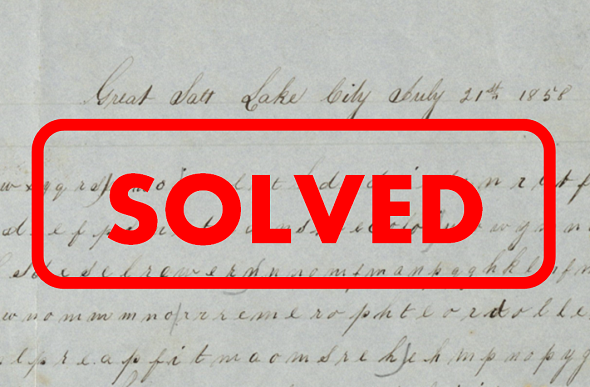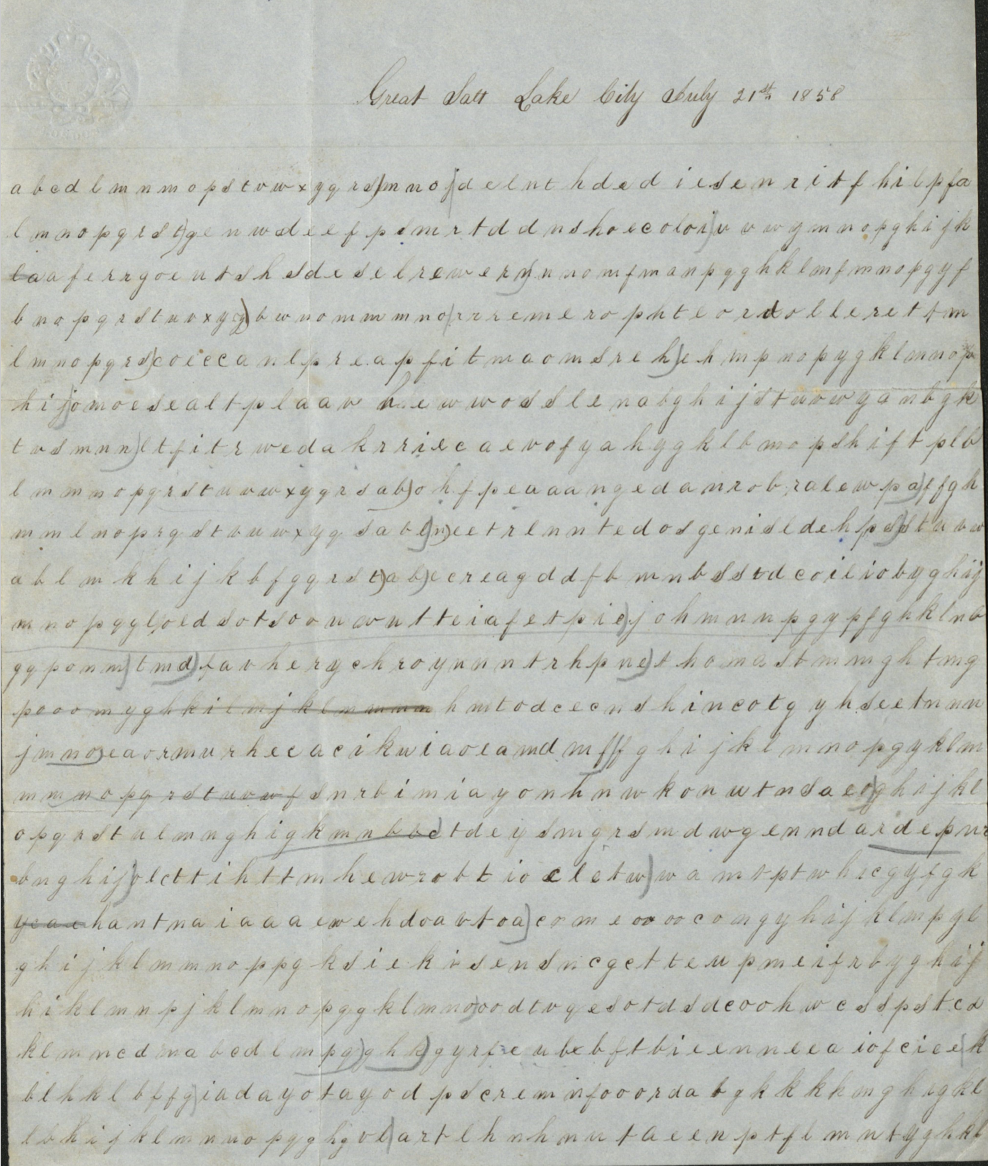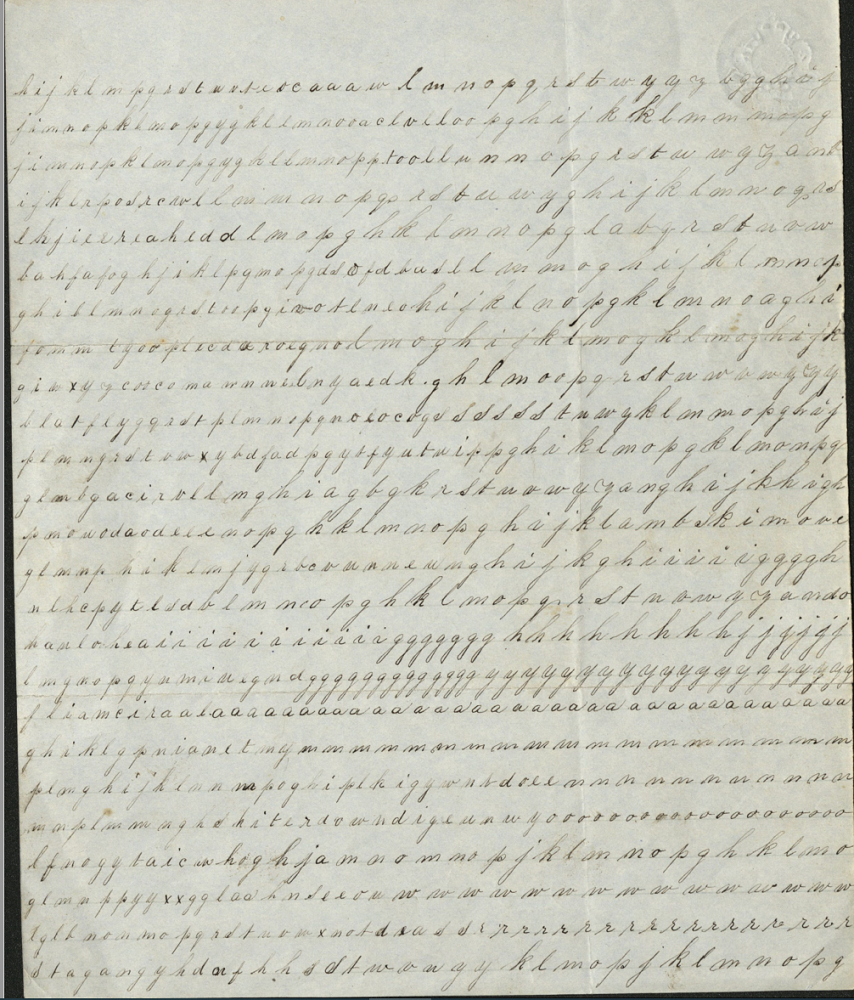The first page of the Utah war cryptogram is solved, can a reader break the second?
Adam Sampson hat den ersten Teil des Utah-Krieg-Kryptogramms aus dem Jahr 1858 dechiffriert. Die zweite Seite ist wahrscheinlich ähnlich verschlüsselt, aber noch ungelöst.
Two weeks ago I blogged about the Utah War Cryptogram (English original/German translation). This was made available to me by the historian Kenneth L. Alford, from Brigham Young University in Utah (USA) through the mediation of Robert Simpson from the National Cryptologic Museum of the NSA.
The Utah war cryptogram
The Utah War Cryptogram is an 1858 two-sided letter sent during the Utah War (1857-1858) from Salt Lake City, now the capital of Utah. Unfortunately, nothing is known about the sender, recipient, or contents of this letter.
The letter in question has been in the possession of Yale University for 50 years, who bought it from an antiquarian bookseller at the time. The cryptogram was uncatalogued until recently. Current Yale curator Bill MacKinnon sent a copy to Alford, one of the leading experts on the Utah War.
The following scans show the two sides of the cryptogram:
Adam Sampson, of whom more will be said, has made a transcription:
abcdlmnmopstvwxyqrs)mnoj)@delnthdediesenribfhilpfa
lmnopqsdt)g@enwdeefpdmrtddnshorcoloi)vvwymnopqhijk
ba)@aferrgoentshadedelrewern)nomfmanpqqhklmfmnopqyf
bnopqrstuvxyy)bwnommmno)@rrremerophteordsllerettm
lmnopqsd)@coecanlpreapfitmaomsreh)ehmpnopygklmnop
hij)@omoesealtplaanhewwosslenabghijstwvwgambgk
tvsmmn)@ltfitrwedakrriecaenofyahygklbmopshiftplb
lmmnopqrstuvwxyqrdab)@ohfpeaaangedamrobralewpa)ffgh
mmmlnoprqsttuwxyqsabb)@neetrlnntedosgenisldehps)stabc
ahlmkhijkbfgqrst)ab)@ecreagddfbmnbsstdcoiliobygdij
mnopqy@l)oedsotsoouwutteiafetpie)johmnnpgypfghklnb
qyponm)@tmd)favherychroynnntrhpne)thomastmmghfmg
pooomygjkilmjklmmmm)@hmtodcecnshincotgyhseetnnn
jmmo)@eaormurhecacikuiaoeamdmf)fghijklmnopqyklm
mmnopqrstuvwf)@snrbimiayonhnwkonwtnsaeo)ghijkl
opqrstulmnghijkmntbe)@tdeysmgrsmdwgenndaidepnr
dnghij)@olcttihttmhewrobtiocletw)wamtptwhieggfgh
y@cae)hantmaiaaaewehdoavtoa)ermeoooocomgyhikklmpgh
ghijklmmnoppg@ksiekisensncgctteupmeifrbyghij
hiklmnpjklmnopqgklmno)oo@dtvqesotdsdcoohwcsspstcd
klmnedmabedlmpq)ghk)gy@rfeubbftbieenneeaiofciee)d
blhklbffg)@iadayotayodpscremnfooordabgkkkkongkigkl
lbhijklmnnopqghj@vl)artlhnhnutaeenptflmntyghkl
hijklmpqrstuv)seocaaaw)lmnopqrstwyqzbggrsxj
jimmopklmopgygkllmmo)oaclvlloo)pghijkklmmmopg
jimmopklmopgygkllmmopp)toollu)nnopqrstwwyzamt
ijkl)rposrcw)llmmmopqrstuwyghijklmnoqrs
lhj)ieereahedd)lmopqhklmnopqlabqrstnow
bahfafoghjihlpgmopg)dsofdbasl)lmmoqhijklmnop *
ghillmnoqrstuvpg)irotlneo)hijklnopqklmnoaghi *
fommtgooplec)daroegno)lmoqhijklmoqklmoghijk *
giwxyzcoocomamnm)ebnyaedk)ghlmoopqrstuwvwyzy
blarflygqrstplmnopqno)eocogsss)ssstuwyklmnopqbij *
plmngrdtvwxybdfadpqy)sfyutuip)pqhiklmopqklmonpq
gl)mbgacirv)llmqhiagbakrstuowyyanghijkkigh **
pmouodaode)eenopqhklmnopqhijklnmbekimooe
glmnphiklmjyg)rbovnnneun)ghijkghiiiiiggggh
nlhcpyclsdbl)mncopghklmopqrstnowyyamdo
k)aulohea)iiiiiiiiiiiggggggghhhhhhhhjjjjjj
lmgnopqy)nmiuegnd)gggggggggggggyyyyyyyyyyyyyyyyyyyy
f)liamciraal)aaaaaaaaaaaaaaaaaaaaaaaaaaaaaaaaaa
ghi)klgpnianetmy)mmmmmmmmmmmmmmmmmm
plmghijklmnmpoghi)plkigywnsdoee)mmmmmmmmmmm
mmplmmmghskiterdowndigeunwyoooooooooooooooooooo
lfnoyytaicwho)ghjamnommopjklmmopghklmo
glmnppyyxxgglaa)hnseeou)wwwwwwwwwwwwwww
lgtbnonmopqrstuvwx)notdsass)rrrrrrrrrrrrrrrrrr
stagangyhdnf)hhsstwvwyyklmopjklmnopq
Special features
Even a glance at the first line shows a special feature:
This line starts with ABCDLMNMOPSTVWXYG, i.e. with letters in alphabetical order. My guess was that the station encoded the first letter in plain text with A, the second with B, the third with C, and so on. However, this would have meant that there was only one repetition (the M) in the first 17 letters, which is very unlikely.
Also unusual are the many letter repetitions on the second page.
My guess was that it was used to encode numbers (for example, 17 As in a row could stand for the number 17).
After my blog article little happened at first. There was only one comment. On December 12, I presented the Utah War cryptogram in my online talk on unsolved ciphers (along with Elonka Dunin, the co-author of my current book) on the ICCH forum. There were interesting discussions about it, but nobody came up with the solution.
ICCH talks (they are given in English), by the way, are held every two weeks on Saturdays and are usually very exciting. Unfortunately, there is no website for them, and the participation links are deliberately not published on the Internet. Nevertheless, everyone is welcome and participation is free. If you want to attend, feel free to send me an email. The only disadvantage is that the lectures overlap with the sports show.
An (incomplete) solutionn
The ICCH talk was also listened to by crypto expert Adam Sampson (I think he is British, but don’t know for sure). A few days ago Adam posted the solution to the first page of the Utah cryptogram on the mailing list belonging to the ICCH forum. He wrote:
I’d spotted that on both pages, the runs of alphabetic sequences and
repeated characters don’t continue across line breaks, which suggested
that the line structure was important and the runs were probably filler.
There are also some pencil marks that look like they’re dividing the
lines into sections. This turned out to be right (although not all the pencil marks are
correct!): each line has a variable amount of junk at the start and the
end, and on the first page there are 24 meaningful characters on each
line.
Mit anderen Worten: Die ungewöhnlichen Buchstabenfolgen wie “abcdlmnmopstvwxyg” sind nur Füllmaterial. Pro Zeile auf der ersten Seite zählen nur 24 Buchstaben, der Rest ist bedeutungslos. In der In other words, the unusual letter sequences like “abcdlmnmopstvwxyg” are just filler. Only 24 letters count per line on the first page, the rest is meaningless. In the first line, the letters “delnthdediesenribfhilpfa” are relevant. In the following transcription of the first page, the filler material is omitted:ersten Zeile sind die Buchstaben “delnthdediesenribfhilpfa” relevant. In der folgenden Transkription der ersten Seite ist das Füllmaterial weggelassen:
delnthdediesenribfhilpfa enwdeefpdmrtddnshorcoloi aferrgoentshadedelrewern rrremerophteordsllerettm coecanlpreapfitmaomsrehe omoesealtplaanhewwosslen ltfitrwedakrriecaenofyah ohfpeaaangedamrobralewpa neetrlnntedosgenisldehps ecreagddfbmnbsstdcoiliob loedsotsoouwutteiafetpie tmdfavherychroynnntrhpne hmtodcecnshincotgyhseetn eaormurhecacikuiaoeamdmf snrbimiayonhnwkonwtnsaeo tdeysmgrsmdwgenndaidepnr olcttihttmhewrobtiocletw caehantmaiaaaewehdoavtoa ksiekisensncgctteupmeifr dtvqesotdsdcoohwcsspstcd rfeubbftbieenneeaiofciee iadayotayodpscremnfooord vlartlhnhnutaeenptflmnty
Now you can read the plaintext column by column:
Dear Colonel,
The stock driven from the command last fall were offered to, received
and receipted for by the quartermaster, a sad mistake by the General.
Gov. Cummin is bold for law and the rights of the people, and
Sec. Hartmett and Suprtdnt. Forney stand by him. The pageboys
commissioners talked much and handed us the pardon, which we accepted as
far as burning wagons and driving stock were concerned. The rest you
know. There is some contention between the law-abiding and the camp
followers. Can you aid us in the removal of the troops? Officers,
soldiers and camp followers feel themselves completely whipped. A
petition for the appointment of certain men has been forwarded y
So it is a transposition cipher. Congratulations to Adam Sampson!!! That was a great codebreaking performance!
Unfortunately, I can’t do much with the content of the plaintext, since I don’t know the historical background. However, I suspect Ken Alford may have something to say about it.
Open questions
Adam Sampson has of course also looked at the second page of the letter, but so far without success. Presumably, the plain text is coded in eight columns, the rest is filler.
Will a reader find out more? Adam has posted a Python program here – perhaps this will help someone.
Thanks again to Ken Alford for the cryptogram and to Adam Sampson for the solution!
Follow @KlausSchmeh
Further reading: Two Pigpen postcards from Ohio (1)
Linkedin: https://www.linkedin.com/groups/13501820
Facebook: https://www.facebook.com/groups/763282653806483/






Letzte Kommentare